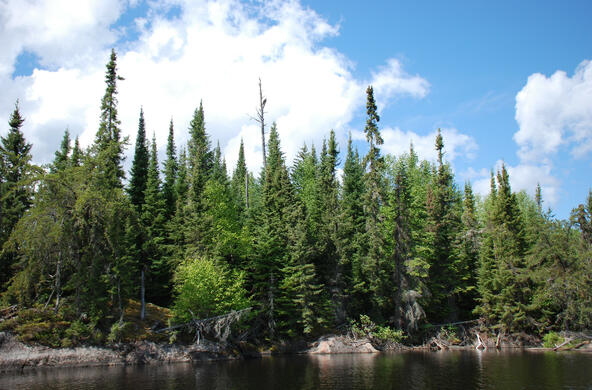Climate change is having a profound impact on animal habitats, but what disease risk does this pose for humans?
Scientists estimate that almost 75 percent of new (and re-emerging) diseases affecting humans at the beginning of the 21st Century were transmitted through animals. Among these so-called "zoonotic" diseases are AIDS, SARS, H5N2 avian flu and H1N1, or swine flu.
Barbara Han, from the Cary Institute of Ecosystem Studies, describes bats, pigs, and birds as "mixing vats" for viruses like Ebola, Hendra, Nipah, avian and swine flus that can spread to humans. As wild animals lose their habitats through deforestation, they come into closer contact with domestic animals and people. Extreme weather events and a warmer climate are also disrupting animal habitats, breeding cycles, and migration patterns.
With so many variables in the equation, drawing correlations between climate change and disease poses enormous challenges for scientists. Vector-borne diseases like malaria, Lyme, dengue fever, West Nile and chikungunya offer the clearest examples of how a warming earth is impacting on disease spread, scientists say. As the earth heats up, pathogen-carrying mosquitoes and ticks are moving further north, spreading these disease into countries and regions not previously affected, like the northern states of the United States, Canada, Sweden and parts of Europe. Dengue fever, which currently infects around 400 million people every year, could spread to as many as five or six billion by 2080 as temperatures continue to rise, according to the Intergovernmental Panel on Climate Change.
Besides these vectors moving into areas of higher latitude and altitude, there is also evidence to show that more extreme and uneven weather patterns and catastrophic weather events such as floods can contribute to the spread of these diseases, says Han.
More or less malaria?
The World Health Organization, while acknowledging that "measuring the health effects from climate change can only be very approximate", nevertheless predicts that in 15 years time a quarter of the 250,000 potential annual deaths from climate change could come from malaria spreading into new areas.
However, whether more people will get sick as a result of these shifting disease patterns is not so easy to determine, says Richard Ostfeld, also from the Cary Institute. "There is some evidence to show that as vector-borne diseases spread northwards, they're also disappearing from really warm places that are getting too warm. There is also some evidence that malaria will start to decline or disappear from areas that are getting too hot or too dry," which could mean, says Ostfeld, that "there is no net change in the number of people at risk."
With so many variables in the equation, drawing correlations between climate change and disease poses enormous challenges for scientists. There is no earth-mimicking laboratory for control experiments to be conducted, for one thing. For another, teasing out climate change from human-driven loss of animal habitats is difficult, when the two are closely linked and often impact on each other. Not only are the clearing of forests and planting of exotic species having a profound impact on animal habitats, but increased urbanisation and development is also contributing to a warmer planet.
"It's much more complicated than people seem to think," says Han. "Part of the problem with communicating climate change is that when you communicate the complexity you risk losing the attention span of the public. Simplifying it creates polarising debates that plays into different agendas," she says.
Ebola?
For these reasons, some researchers were wary of being interviewed. A couple were blunt about the fact that – despite media reports to the contrary – the recent Ebola outbreak in West Africa could not directly be attributed to climate change.
Many scientists are unequivocal that a link between climate change and disease spread to humans can be made. Some scientists have speculated that extreme weather patterns may have played a role in the outbreak: dry seasons followed by heavy rainfall have caused fruit to proliferate, possibly bringing bats and apes together and allowing the disease to transmit between the species. Deforestation has also steered bats ever closer to humans to find food. Another hypothesis is that climate change, by diminishing traditional food sources and causing more people to eat bush meat (one way of transmitting the disease), has helped to spread Ebola.
But biological anthropologist Peter Walsh, from Cambridge University, says there is very little data to support claims of climate change and urbanisation contributing to Ebola emergence, "and there is a lot of data that doesn't."
"The vast majority of outbreaks have occurred in really remote areas and not heavily settled areas," he says, adding that while there is some evidence of "seasonal variation of outbreak probability," there is no credible evidence that "outbreak probability has increased with a warming climate".
'Not whether, but how'
Nevertheless, many scientists are unequivocal that a link between climate change and disease spread to humans can be made. The difficulty is proving causality. Han believes the case "can absolutely be made." The issue, she says, is "not whether, but how".
Certainly fruit bats are garnering plenty of attention in Australia, where their changing feeding patterns, possibly related to climate change, have been linked to the spread of the Hendra virus, which has proved fatal to horses and humans. The Nipah virus, also transmitted by fruit bats, has been passed on to pigs and humans in Malaysia, also with fatal consequences.
"We have strong evidence that land use change and habitat clearing has dramatically changed feeding patterns of fruit bats – flying foxes – in Australia," says Raina Plowright, an infectious disease ecologist at Montana State University. Fruit bats that normally feed off the nectar of Eucalyptus trees are now feeding off less nutritious fruit from trees planted in horse paddocks and peri-urban and urban areas, she explains. "Climate change is having an impact on whether the Eucalyptus trees flower, but we don't have an algorithm to make a direct link between climate change and flowering patterns."
Plowright adds that the interaction between habitat loss and climate change complicates the picture. "These two major processes influence animal behaviors and the spread of pathogens from animals to people, but we don't understand the links very well," she says.
In a paper, she writes that determining the role played by climate change, pollution and ecosystem destruction in emerging infectious diseases can only come about through "systematic interdisciplinary cooperation. By analogy, in a jury trial, multiple lines of evidence that connect the suspect to the crime scene, the weapon, and the motive are often required before a verdict can be reached."
The established links
The way climate change is affecting disease patterns in animals is easier to demonstrate in some cases, say scientists. Research on monarch butterflies in the United States, for example, has shown how a combination of climate change and the introduction of an alien milkweed species, has affected their migration patterns and increased disease levels.
Ecologists Dara Satterfield and Sonia Altizer from the University of Georgia explain how exotic milkweed often grows year-round in the southern US when winters are warm, without many hard freezes. Climate change could worsen the problem. The pathogens on the milkweed, which normally die off on native milkweeds during cold winters, can now accumulate on the plants all year, sickening the butterflies.
Ostfeld, from the Cary Institute, adds that other, better-studied diseases – such as blue tongue virus, which attacks sheep and goats and is transmitted by biting midges – are on the increase because of warming climates in Europe.
Another excellent example, he adds, is avian malaria in the Hawaiian islands. The parasite is transmitted by mosquitoes that – as the climate warms up – are moving up in elevation and attacking naive, vulnerable populations of birds. "The climate link is pretty well established there," Ostfeld says.
Increased threat
Avian flu or H5N1 that emerged in China in 1997 raised widespread panic about the potential of a pandemic. Researcher Kurt Vandegrift, who co-authored a paper entitled, "Ecology of avian influenza viruses in a changing world," says he sees climate change as one of many "threat multipliers", that could impact on migratory behaviour and potentially trigger new bird flu outbreaks.
"Land use change that leads to higher waterfowl densities, stress, or proximity to domestic birds, will likely lead to increased influenza transmission within flocks and increased cross-species transmission," he writes.
California's wetlands have diminished by 90 percent, which has reduced their stopover locations. "This decline in stopover locations for migrating waterfowl must lead to more crowding and increased contact rates which, if transmission is density dependent, will lead to increased prevalence and increased potential for recombination events of viruses like avian influenza," Vandegrift told IRIN.
However, while he says climate change could have an impact on "avian influenza epidemiology," exactly how remains an unknown. "We can't put fly-way paths in environmental chambers so it's really difficult to make predictions."






